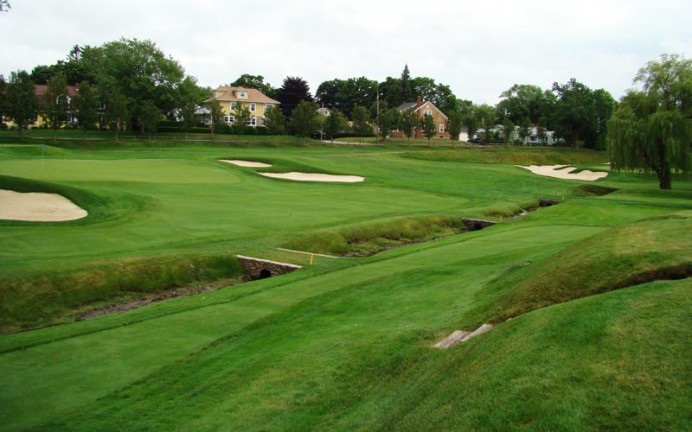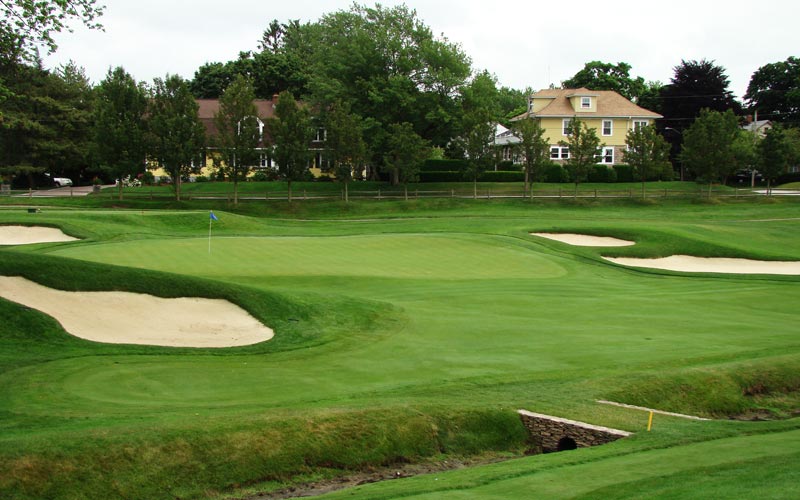Wannamoisett
Rhode Island, United States of America
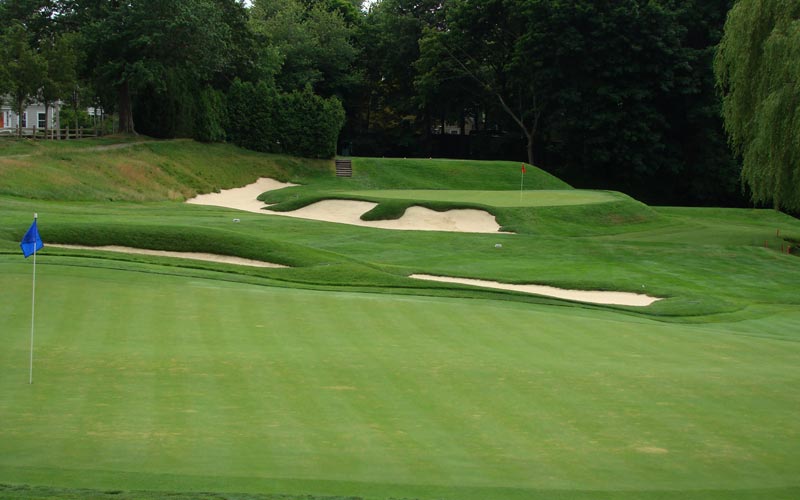
All any architect can do is get the most from the property with which he is given to work. In that regard, Donald Ross set one of the gold standards in golf course architecture with his work at Wannamoisett. Above is a view across the second green to the famous one shot third hole.
The Wannamoisett golf course in Rumford, Rhode Island has everything and yet the property didn’t. The fact that Donald Ross managed to get so much out of seemingly so little is testimony to his skill as an architect (it is also testimony to the fact that his Rhode Island summer office wasn’t far away).
It is well documented that Wannamoisett occupies only 104 acres. What isn’t as well known is the variety that Ross enthused into each hole. The two-shot holes in particular are a fascinating mix and taken as a group, they are of singular merit. There are several monstrously difficult par fours, two of them (the second and ninth) requiring forced carries over gullies. On the shorter length par fours like the fifth and seventh, the golfer may well hit the green only to appear foolish as his putt from the back rolls off the front. In between, there is a host of fine two shotters that are nicely varied.
The art of fairway bunkering is alive and well at Wannamoisett. There are fifty-six fairway bunkers on the front nine alone (compare that to Augusta National for instance). Not only is length required off most tees, but the better golfer is always given something to do. Can he fade the tee ball around the bunkers on the inside of the fifth hole? Can he rifle a straight shot down the seventh fairway, avoid six fairway bunkers and stay on a ridge? Can he draw it up the throat of the tenth fairway? Does he carry the pond at the fourteenth with a driver or lay off to the left? Decisions, decisions, which is exactly what makes any course fun not just on the first round but for many thereafter.
At Wannamoisett, once you are in the fairway, the fun is just beginning. The approach shots vary from a hard chasing shot that runs onto the first green to flying the brook at the second, to hitting a plateau green on the third; you get the point. Ross excelled (even for him) in the green site selections at Wannamoisett. Many good golfers will tell you that these are among Ross’s top five finest sets of greens. What’s ironic about that is that Wannamoisett came relatively earlier in Ross’s career. Later, he would build some wildly sophisticated greens like at Mountain Ridge and Plainfield in New Jersey with six feet plus of back to front slope and wild interior contour. Still, the ones at Wannamoisett are so varied and seem to flow so effortlessly out of the ground that they are beyond reproach. In part, credit is due to the club for having been such a good steward over the decades as all the original random undulations remain; the greens have never been touched, except to expand them out in their original size.
Ross expert Ron Forse has been working with the club since 2008 and has come to marvel at the variety found within the greens. As he states, ‘some of the greens like the second and tenth are hunkered down while others like the first and fourth are set at grade and then some of Ross’s very best are the ones found on natural plateaus like the fifth and seventh. All in all, the natural setting of the green sites makes Wannamoisett remarkable.’ Hitting the correct shot that allows the golfer to stay on the right side of the hole is an exercise in skill. Given today’s conditioning of the greens and their pacing, the golfer will soon appreciate the value of keeping the ball below the hole. The praise generally heaped on Inverness’s small undulating greens is equally deserved here.
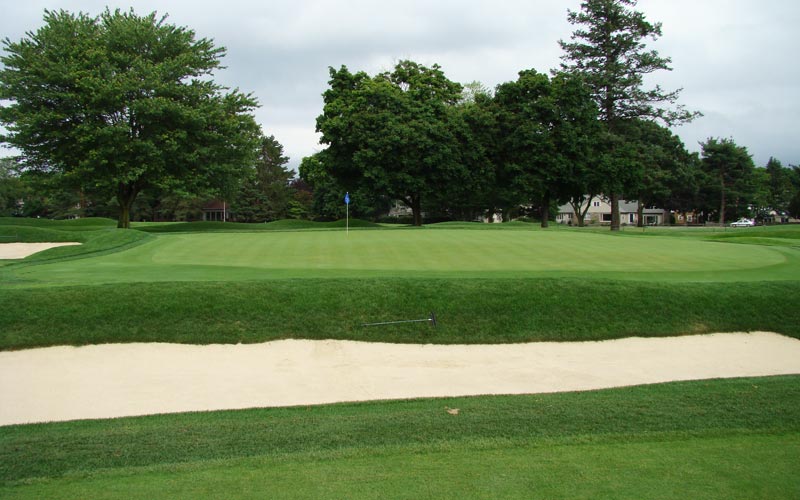
Ross does a particularly fine job of rotating what he asks the golfer to do. At the tenth, the golfer may elect to land his ball some ten yards short of the punchbowl green and have it bound on. On the very next hole, Ross walled off the entrance to the green.
The cumulative result from the tee until the putt drops is a course that is good enough to test the best. Since 1962, Wannamoisett has hosted the Northeast Amateur, one of the most prestigious and important amateur events conducted in the United States. The course is closed for a week and the members open their home doors to the contestants. The list of past champions from Ben Crenshaw to David Duval attests to the quality of the design.
Holes to Note
First hole, 430 yards; Be ready. While waiting to play during a rain delay, several members approached the author and said words to the effect of “Don’t get too discouraged. After the fourth hole, you will be okay.” What a strange way to introduce your course and yet they were absolutely right. Speaking of rain, that’s a non-issue for Wannamoisett as the property is blessed with sandy soil throughout. The rock clusters that Ross would later bury underground at other New England stand-out courses like Salem Country Club and Essex County weren’t a factor. No doubt the quality of the sandy loam soil was a big help to Ross when he started crafting the greens and some of their subtle slopes like the ones found here at the first. In turn, these subtler features play so well because of the consistently firm playing conditions that Green Keeper Mark Daniels achieves from the sandy soil.
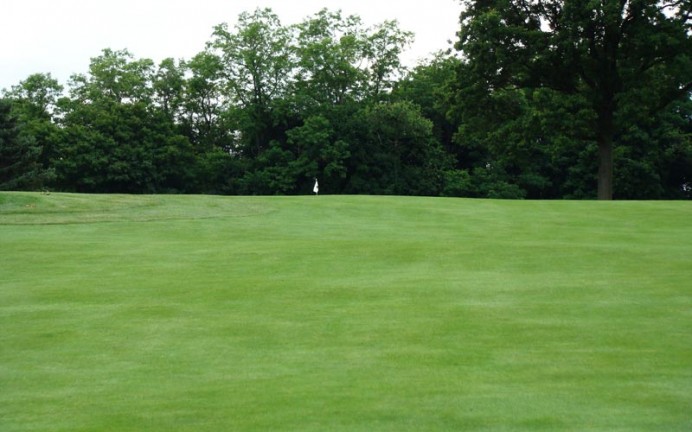
True lay of the land architecture involves shots like this with the flag barely visible above the brow of a hill. Too many modern architects would make a heinous cut in the fairway to provide perfect visuals of the putting surface – and what a shame that would be as the charm/mystery on the approach shot would be diluted.

Forse restored this pair of bunkers that Ross had built into two mounds that guard either side of the first green. While Ross would stop building bunkers in such an artificial manner by the 1920s, such eccentric features are why some students of architecture prefer Ross’s courses built in the first half of his career to the more conventional ones later on.
Second hole, 505 yards; ‘Ferocious start’ and ‘Wannamoisett’ go hand in hand which is ironic because that wasn’t the case when the course first opened in 1916. At the time, this 465 yard hole was a par five (as was the ninth) with a majority of golfers forced to lay-up of a gulley and brook short of the green. Of course, even in this day of 460cc drivers as opposed to the hickory clubs back then, many of us still treat the second as a par five! This is especially true ever since Forse found room to add a new back tee in 2009, adding forty yards to the hole. At over 500 yards in length, top amateurs get a quick introduction to the fact that this par 69 course packs quite the punch.

If the golfer’s tee ball doesn’t find the fairway at the second, most elect to lay-up short of the gulley and care then needs to be taken not to get in this string of bunkers down the right side.
Third hole, 135 yards; Ross was a fan of ‘scooped-out pits’ and this hole is a prime example. One large bunker materializes out of the hillside on the left and sweeps around in front of the built-up plateau green that falls away steeply to the right. You either find the small target off the tee or you have an interesting recovery shot – and the small target is just plain difficult to find. A hole of this length that requires precision is the perfect foil to the mugging the first two holes provide. The Donald Ross Society thinks so much of it (and the course) that the third is their logo.
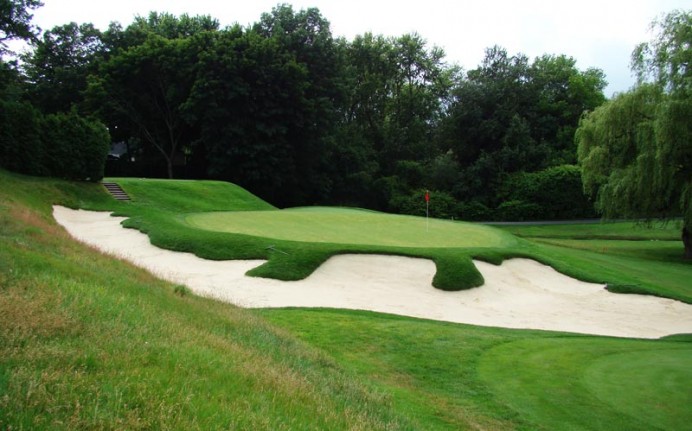
The pushed up, 3,200 square foot third green is tightly defended, entirely appropriate for a hole of modest length.

Don’t even think about chasing after the back right hole location that Forse and the club have recently recovered as the tight grass to the right of the green leaves a very difficult recovery.
Fourth hole, 440 yards; Given that Wannamoisett came early in Ross’s career, there wasn’t any certainty as to what design principles he would necessarily apply here. Yes, his background from Dornoch and his superlative work at Essex County Club boded well but penal courses like Oakmont carried great sway pre-World War One. If there was ever any doubt though, Ross from this earliest days embraced strategic design elements and that penchant is showcased with the bunkering at the fourth. Talented golfers who avoid the fifty-eight yard long bunker that hugs the inside left of the fairway are rewarded with a clear shot to a green that is open in front. However, standing on the tee, most of us steer right away from the out of bounds and from that long, snaking bunker. In turn, we are left with a semi-blind approach over a large bunker that is 100 yards from the center of the green. Not only does depth perception become an issue but Ross used that forward bunker to mask two smaller bunkers on the right of the green that gather as many approach shots as the green. Does the golfer who can shape his tee ball from right to left appreciate the advantage that he gains? Absolutely. Hence, better amateur players are as quick to mention Wannamoisett as any course in the golf rich northeast of the United States.

The holes hit the landforms in all sorts of ways. As opposed to carrying the gulley with one’s approach at the second, the golfer must now carry it off the tee at the fourth.
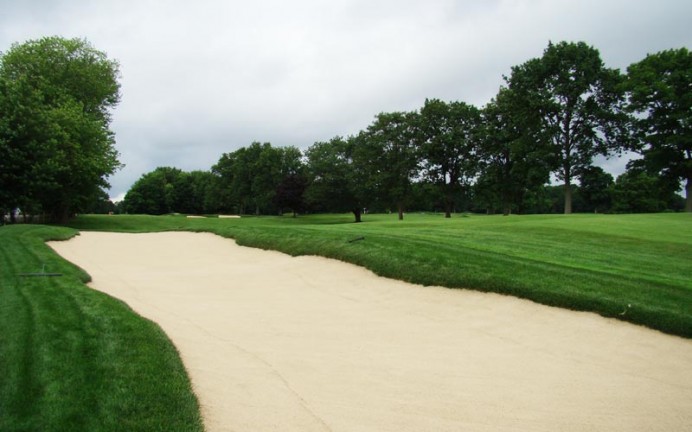
Ross’s bunker ‘style’ resists being stereotyped at Wannamoisett, which speaks well as to the variety of shapes and sizes that he employed. This bunker to the left of the fourth fairway is much longer than it is wide and the fourth fairway bends around it.
Fifth hole, 370 yards; The property line that borders the fourth and fifth holes is essentially straight and yet Ross saw to it that the fourth bends to the left and the fifth bends to the right, thereby avoiding the sense of monotony that frequently accompanies one straightaway hole after another. In this case, Ross built three fairway bunkers with tall faces and then bent the fifth fairway to the right around them. While Wannamoisett wasn’t feature rich, it did have a dominant ridge that ran through a third of its mid-section. Ross seized on it where ever possible, starting here with a knob of a green. As a sign of his efficiency, he also found room on this 300 yard long rise for the eighth tee, seventh green, twelfth green, fifteenth green and sixteenth tee. In particular, his handiwork at the fifth and seventh green complexes stands out.
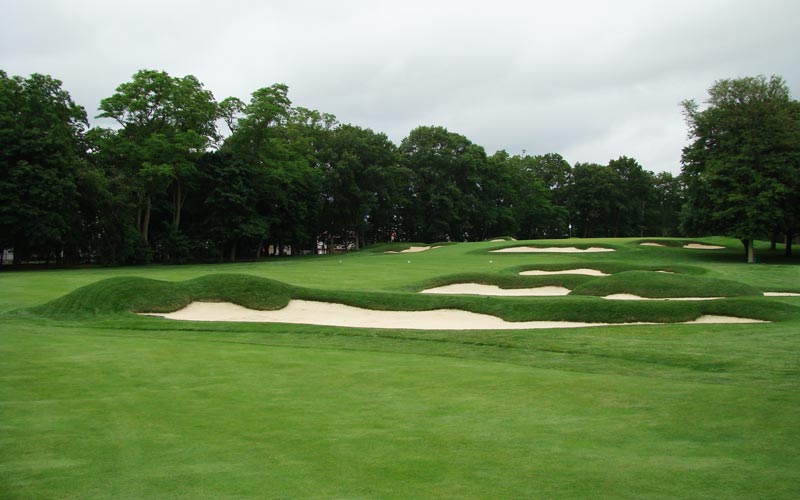
Ross’s distinctive fairway bunkering with its tall grass faces forces the golfer to stay to the left. If ever a course plays to its full yardage, it’s Wannamoisett.

Opened for play in 1916, the superb green complex at the fifth is as sure a sign as any that Ross was an immense talent.
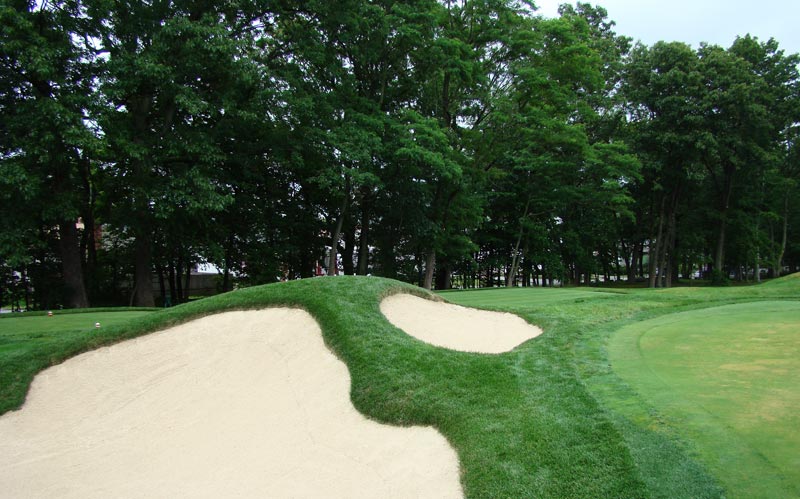
Few courses in the United States feature shorter green to tee walks than at Wannamoisett. Pictured above is the left edge of the fifth green with the sixth tee just six paces away!
Seventh hole, 345 yards; Holes like this and the thirteenth at Pinehurst No. 2 prove that holes don’t have to be long to challenge the good player. Give Ross credit for capturing an interesting spine within the fairway and the skilled golfer is delighted if he can successfully stay on top of this spine and avoid the six fairway bunkers. From there, he enjoys the best look at the green which falls away both front and back. In recent times, the green was wisely extended back as close as possible to the hidden back-right bunker. Especially with short-irons, it takes more nerve to attack a hole that has danger beyond it than it does in going after a hole just over a hazard.
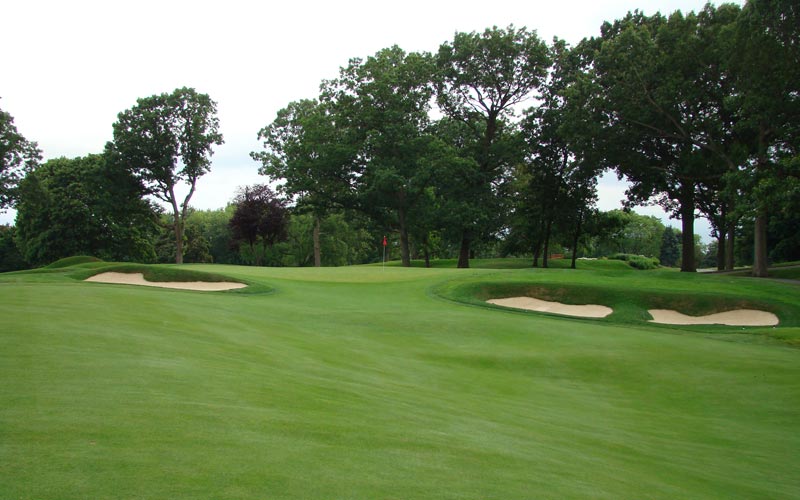
Ala the fifth green, Ross took advantage of the ridge line running through this portion of the property to create another doozy of a green complex, complete with a false front – and a false back! In the foreground is the spine that the golfer would dearly love for his tee ball to stay a top as it provides the perfect angle (as well as the most level stance) to approach this green.
Ninth hole, 455 yards; Several new tees (most notably at the second) have seen to it that Wannamoisett now measures almost 6,750 from its back markers. That sounds manageable until you realize that you are only given 69 strokes to cover that distance. If Wannamoisett was a traditional par 72 by having three more par fives, it would measure over 7,000. As it is, there is only one par five for the professionals/top amateurs to try and beat up on. That leaves a bunch of hard par fours and in fact, out of the first ten holes, six are par fours that measure over 420 yards. Thus, rather than comforting the golfer, a study of the scorecard should make him realize that he is in for quite a tussle. The ninth symbolizes the course’s demand for accurate driving (the drive must find the fairway and not one of its seven bunkers) and controlled mid-iron approach shots.

Ross put the natural water hazard directly in play when he placed the ninth green on the far bank. In 1916, it was a risk/reward par five but when the scorecard was changed from a par five to a four after World War Two, the hole became a beast.
Tenth hole, 420 yards; Given that the tenth plays up the same the general hill as the first hole, one of Ross’s challenges was to give each hole its own character. He admirably succeeded with both being among the finest on the course yet entirely different from one another. To this day, Forse marvels at how much Ross got out of this site using a light touch and the bunkerless tenth green set in a natural bowl epitomizes ‘less is more’ architecture.

Despite playing up a gradual slope, the tenth is full of visual appeal thanks to Ross’s staggered bunkering scheme.
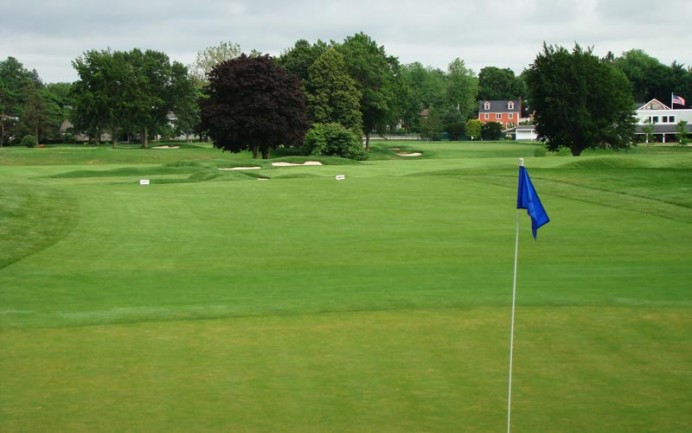
Looking back, the tenth fairway is to the left of the tall flagstick (the ninth fairway is to the right).
Twelfth hole, 210 yards; “The finest one-shot hole in the nation” according to Ross and yet to start with all he had was the broad slope up a hill. From that less than promising beginning, he dug out a cavernous bunker in front and created a shelf green whose interior resembles a punchbowl. How many architects could create a long par three that is both uphill and stunning? Not many.
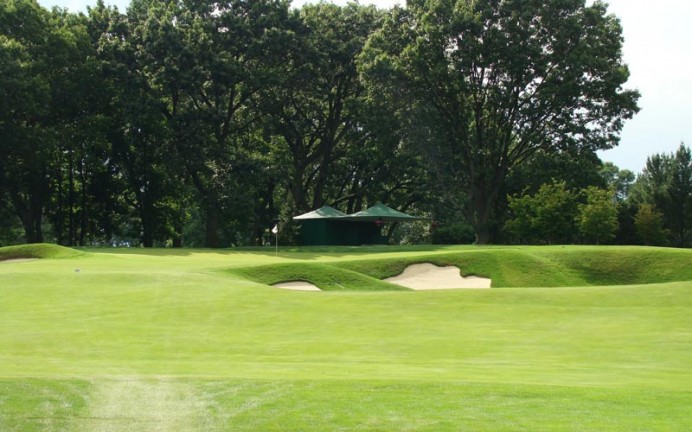
By digging out the crater for the Sahara bunker, Ross generated plenty of fill for the green pad. The fact that a young Ross was able to tie everything off nicely with its surrounds is but another example of the talent that he possessed early in his career.
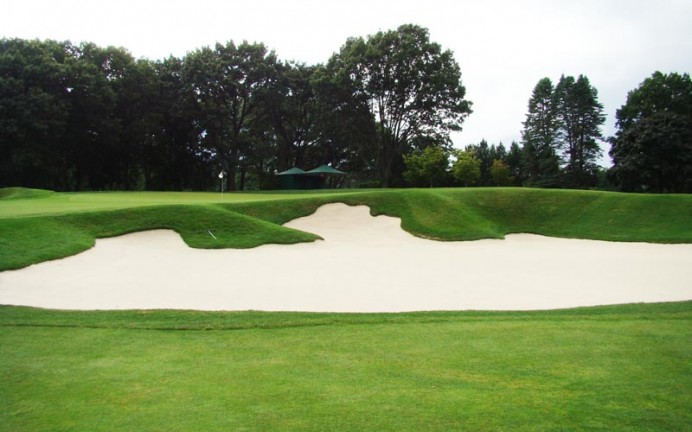
Closer inspection shows why the twelfth is aptly named Sahara! Remember too that the sand wedge wasn’t invented until this course was over ten years old. Early golfers would have been laying open their niblicks (today’s nine iron equivalent) and hoping for the best.

Given the fearsome fronting hazard, Ross favors bold play at the twelfth where he built a ‘backboard’ around the back of the green to contain slightly long tee balls and feed them well back onto the putting surface.
Fourteenth hole, 365 yards; The gulley/creek in front of the second green, the ravine/pond in front of the ninth, the lake here: Ross placed the property’s prominent natural features directly in the line of play. Far too many architects in this age of “playability” place features off to the side of the playing corridors where they lack any ability to dictate play. Such courses quickly become monotonous to play, something that Wannamoisett never has to worry about.
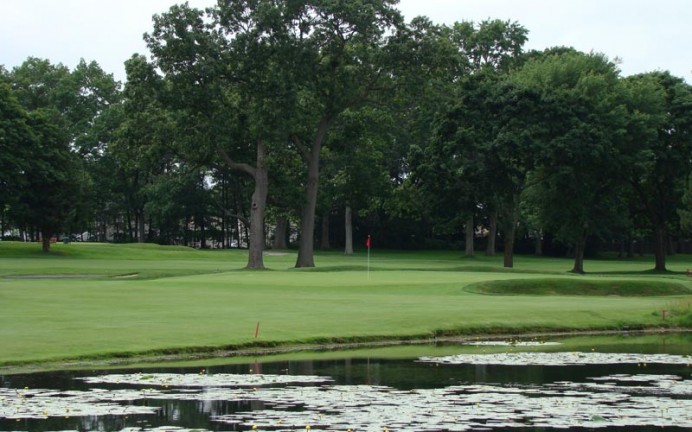
The game has changed since Ross’s day: Some top flight golfers today take dead aim at the fourteenth green from the tee and hope to run it on!
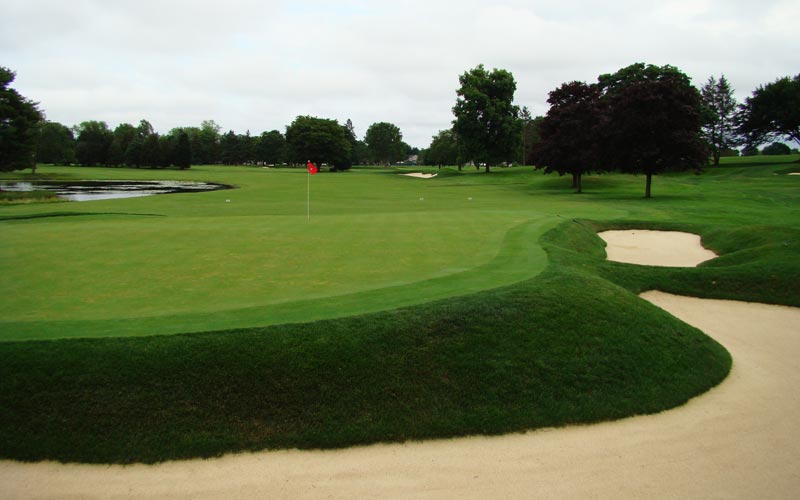
In comparing this photograph from behind the fourteenth with the one above, Ross’s knack is evident for building green pads that rise up and seamlessly appear as an extension of the fairway. Other architects in the 1910s weren’t nearly as talented in making their green complexes appear as natural.
The course doesn’t end with the same bang in which it started but then again few courses could. The seventeenth is now the only par five on the course and it plays along the property’s edge with out of bounds down the left and the eighteenth occupies the least distinctive land of the par fours (no great crime this, mind you). Nonetheless, if Ross were alive, he would be pleased with the presentation of the course, which always held a special place for him. In fact, in June 1926, he wrote to McGovern that ‘this is my best course,’ which is quite the compliment indeed given that he had completed so many of his most famous courses by then (Pinehurst No.2 and Seminole excluded).
Wannamoisett is the exact type of course the author enjoys so much in England. Par is below 70, it is easy to walk, nothing is forced or contrived, and you can play in under three hours. The close proximity of the holes add to the sense that Wannamoisett is a course and not just a collection of eighteen separate holes. Throw in genuine Donald Ross greens, and you have a course of unusual charm and challenge, all in a course under 6,750 yards.
Ross described the ideal course in Golf Has Never Failed Me as “one that presents a test of golf for the everyday golfer and the first class player. A properly designed course can take care of every class of golfer. My aim is to bring out of the player the best golf that is in him. It will be difficult to negotiate some holes, but that is what golf is for. It is a mental test and an eye test. The hazards and bunkers are placed so as to force a man to use judgment and to exercise mental control in making the correct shot.”
What a perfect description of Wannamoisett!
The End


